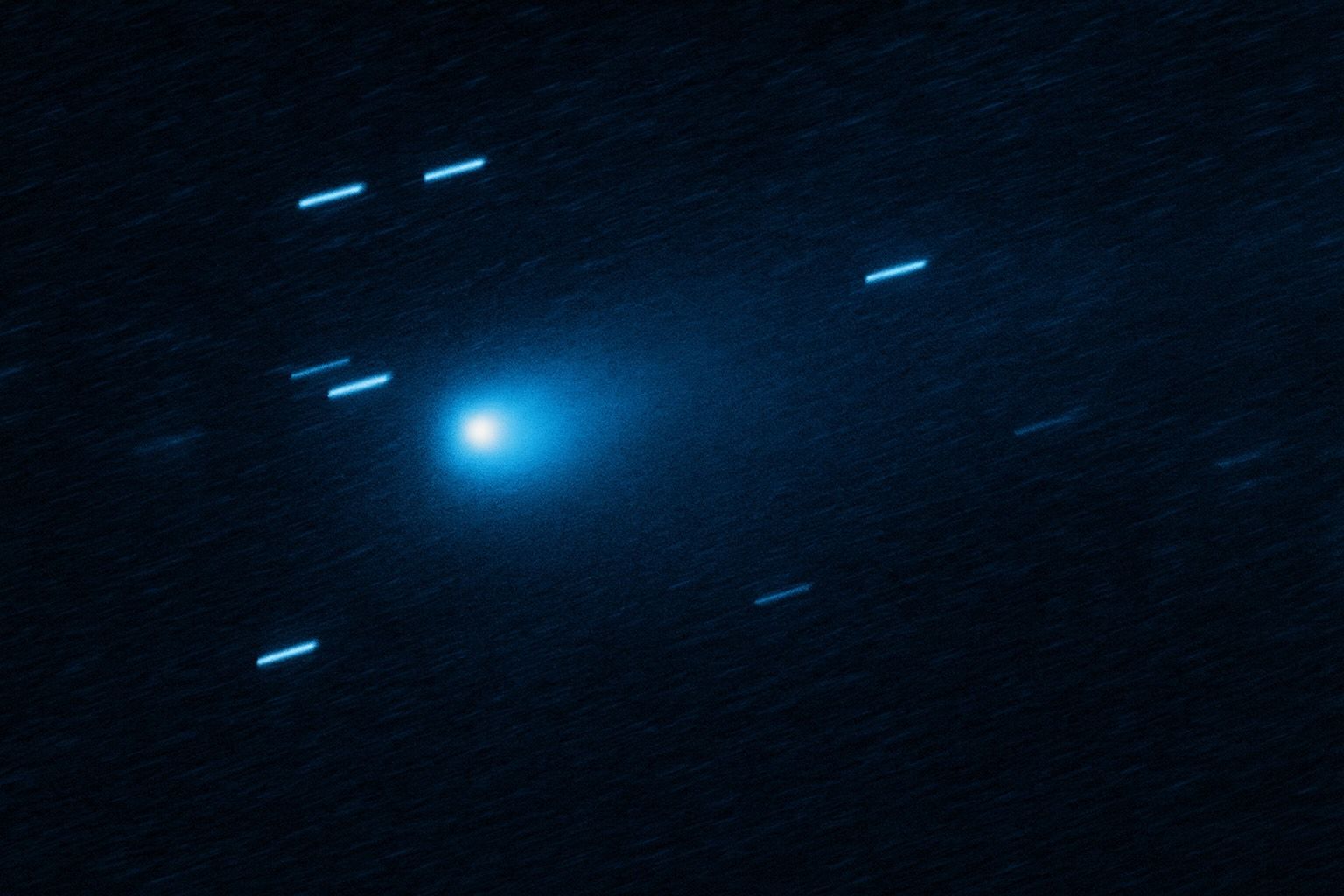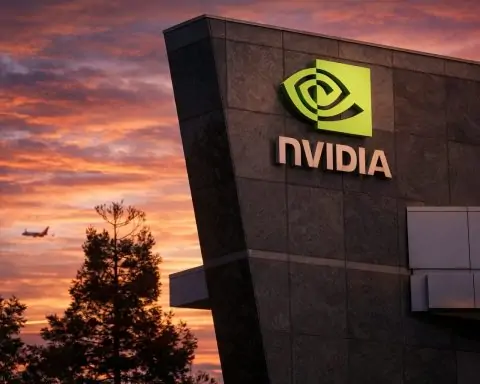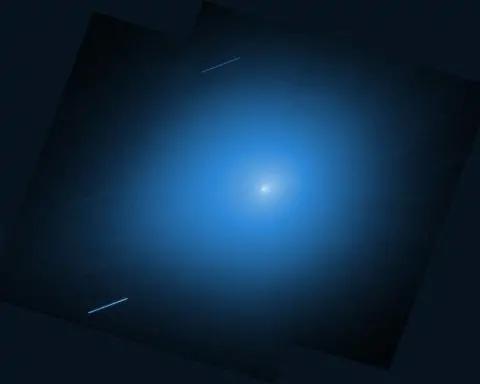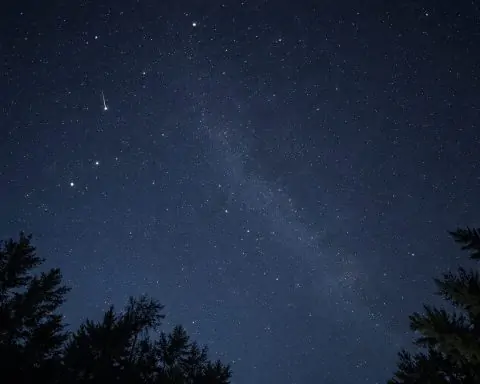- Third Interstellar Visitor: Comet 3I/ATLAS is only the third known object from beyond our Solar System – after 2017’s
ʻOumuamuaand 2019’sBorisov– confirmed on July 1, 2025 by the ATLAS survey in Chile [1]. It follows a steep hyperbolic trajectory (eccentricity ~6.14) at about 58 km/s, proving an extrasolar origin [2]. - Approaching Sun, No Threat: 3I/ATLAS will reach its closest point to the Sun (perihelion) on October 29–30, 2025 at roughly 1.4 AU (130 million miles, inside Mars’ orbit) [3]. It will never come closer than ~1.8 AU (~270 million km) to Earth [4]. Both NASA and ESA emphasize the comet’s path is benign, posing no danger to our planet [5].
- Active Comet with Strange Tail: Unlike the passive
ʻOumuamua, 3I/ATLAS is actively venting gas and dust. Even when far beyond Jupiter in July, Hubble images showed a teardrop-shaped coma and a faint tail [6]. As it nears the Sun, a dramatic jet has been observed blasting toward the Sun – an unusual “anti-tail” phenomenon [7] – while a typical tail has grown pointing away from the Sun [8]. - Unusual Composition: Scientific instruments have found 3I/ATLAS to be rich in carbon dioxide but relatively low in water ice [9]. Spectra from NASA’s James Webb Telescope in August showed an extraordinarily high CO₂/H₂O ratio (~8:1) [10], among the highest ever seen in a comet. The comet is also venting nickel (Ni) gas but with little to no iron (Fe) detected – an elemental quirk never observed in natural comets [11]. This hints at exotic chemical processes (nickel carbonyl formation) occurring in its icy nucleus [12].
- Ancient Time Capsule: Based on its galactic trajectory, astronomers suspect 3I/ATLAS may hail from the Milky Way’s distant “thick disk” of stars and could be over 7 billion years old [13] – potentially pre-dating our Sun. This pristine time capsule from another star system offers clues to planetary formation beyond our solar neighborhood [14].
- Alien Speculation Debunked: The comet’s bizarre features have prompted public speculation – from unfounded “alien spaceship” rumors to one astronomer’s musings that it might be linked to the famous 1977 “Wow!” radio signal [15]. Harvard’s Dr. Avi Loeb even posited the sunward “anti-tail” could be a braking thrust from an engineered craft [16]. Mainstream experts strongly reject these ideas: ESA scientist Dr. Michael Küppers stresses 3I/ATLAS “looks like a comet and it behaves like a comet” [17], and no evidence of any artificial signals or structures has been found [18] [19]. Researchers attribute its odd behavior to natural cometary activity driven by solar heating [20].
- Global Observation Campaign: 3I/ATLAS is the focus of an unprecedented worldwide observation campaign. Two ESA Mars orbiters (Mars Express and ExoMars TGO) captured images during its October 3 flyby of Mars (at ~30 million km) [21] – the first time spacecraft around another planet photographed an interstellar object. NASA’s Hubble and JWST have imaged and spectrally scanned the comet [22]. Ground observatories (Gemini, VLT, Keck and others) are tracking its evolution, and even spacecraft on other missions will gather data: ESA’s JUICE probe will observe 3I/ATLAS in November after perihelion [23], and a new analysis found that ESA’s Hera asteroid mission and NASA’s Europa Clipper will fly through the comet’s extensive tail in the coming weeks [24] [25]. Scientists and citizen astronomers alike are monitoring this cosmic visitor as it races toward the Sun and back out into interstellar space.
Interstellar Mystery Lights Up the Solar System
An interstellar vagabond is currently streaking through our Solar System, and it’s making waves both in the scientific community and the public imagination. Officially designated 3I/ATLAS (C/2025 N1), this object is only the third interstellar visitor ever observed – a comet from another star now paying us a brief visit [26]. First detected on July 1, 2025 by the ATLAS sky-survey telescope in Chile, 3I/ATLAS immediately stood out: it was moving extremely fast on a one-way hyperbolic trajectory, meaning it is unbound to the Sun and came from far outside our Solar System [27]. Its inbound path traced back to no known origin within the Solar System, confirming that 3I/ATLAS originated in the depths of interstellar space.
This discovery comes on the heels of two prior interstellar objects – the needle-shaped 1I/ʻOumuamua in 2017 and the icy comet 2I/Borisov in 2019 [28]. Each of these cosmic interlopers was unique: ʻOumuamua was small, tumbling and showed no cometary coma (fueling wild theories about alien probes), whereas Borisov looked and behaved much like a typical small comet from our own Oort Cloud. 3I/ATLAS, however, is breaking the mold yet again. It is larger and far more active than ʻOumuamua, sporting a visible coma and tail, yet it also exhibits puzzling features that haven’t been seen in ordinary comets – setting off a frenzy of observations and debate. “This object is the largest, fastest-moving, and perhaps the oldest interstellar comet ever seen,” noted Live Science, adding that most astronomers agree it likely formed around an unknown star system far beyond our own [29] [30].
A Cosmic Snowball on a Safe Trajectory
Right now, comet 3I/ATLAS is plunging toward the inner Solar System, on track to reach perihelion (closest approach to the Sun) on October 29, 2025 [31]. At perihelion it will be about 1.36 AU from the Sun – roughly 126 million miles, placing it just inside the orbit of Mars [32]. This is relatively far – Earth orbits at 1 AU – so 3I/ATLAS will not approach the Sun as closely as many Sun-grazing comets do. After rounding the Sun, it will begin its long exit back into interstellar depths, crossing Jupiter’s orbit by March 2026 on its way out [33].
Crucially, 3I/ATLAS will not come near Earth. At its closest, on November 1, 2025, it will still be about 1.8 astronomical units away – roughly 170–270 million miles (far beyond Mars) [34]. NASA underscores that this distance is huge: the comet poses no impact risk or any hazard to Earth [35]. In fact, “Comet 3I/ATLAS poses no threat to Earth”, the agency confirmed in a recent update, explaining it will remain “far away,” never getting nearer than 1.8 AU [36]. ESA echoes that its orbit is completely benign from our perspective [37]. In other words, this alien comet is strictly a spectacle, not a threat.
However, its trajectory did bring it relatively close to Mars earlier this month. On October 3, 3I/ATLAS passed about 30 million km from Mars – by cosmic standards a modest flyby (for comparison, Mars is ~225 million km from Earth on average). Fortuitously, spacecraft around Mars seized the chance to observe it. Between October 1–7, ESA’s ExoMars Trace Gas Orbiter and Mars Express pointed their cameras toward the dim interstellar comet as it flew by [38]. This yielded the closest pictures ever taken of an interstellar comet by human probes [39]. The comet was so faint – “10,000 to 100,000 times fainter than our usual targets”, noted Dr. Nick Thomas, the ExoMars camera lead [40] – that only a fuzzy dot was seen in the Mars orbiter images [41]. Still, the effort marks a historic first. Scientists are now analyzing those data to glean the comet’s brightness and composition. (NASA’s Mars Reconnaissance Orbiter also snapped photos with its HiRISE telescope during the flyby, but as of late October the U.S. government shutdown delayed public release of those images [42], sparking some impatience and conspiracy chatter among enthusiasts.)
Looking ahead, skywatchers on Earth will not get a dramatic view of 3I/ATLAS with the naked eye – it’s simply too far and faint. At best, by December it might be visible in medium-sized telescopes as a small fuzzy star-like object. The real treasure is the scientific data being collected by observatories around the world, which far outweigh any disappointment of backyard stargazers. As one astronomer put it, we’ll miss our interstellar friend, but at least we’ll have the photos and spectra [43].
Sunward “Jet” and the Case of the Vanishing Tail
One of 3I/ATLAS’s biggest surprises is what astronomers saw as it started warming up: the comet shot out a “jet” of material aimed toward the Sun, seemingly opposite the direction a comet’s tail usually points [44]. In late August, images from Hawaii’s Keck Observatory and other telescopes revealed this striking sunward plume of gas and dust protruding from the comet’s coma [45] [46]. The feature was essentially a bright, narrow spike extending roughly 10,000 km (6,200 miles) out from the comet’s nucleus in the sunward direction [47]. Such a formation is commonly called an “anti-tail” because it extends toward the Sun, the opposite of a normal comet tail.
To the public, a sun-facing tail sounds paradoxical – aren’t comet tails always blown away from the Sun by solar wind? In general, yes: comas and dust tails typically stream out behind a comet, pushed anti-sunward by the pressure of sunlight and the solar wind [48]. So why does 3I/ATLAS have a jet pointing sunward? In fact, this comet isn’t the first to display such behavior; the phenomenon is known from a few other comets and usually comes down to geometry and particle dynamics. As Spanish astronomer Dr. Miquel Serra-Ricart explains, jets of outgassing often erupt from the comet’s sun-facing side, and while light dust gets blown back into a tail, some larger dust grains can linger in the comet’s orbital wake, creating the illusion of a temporary sunward spike when viewed from Earth’s perspective [49]. In simpler terms, under certain viewing angles a comet can show a forwards-pointing dust filament – an anti-tail – even while a fainter conventional tail streams out in the opposite direction.
That appears to be what happened with 3I/ATLAS. Throughout August and early September, the comet sported this peculiar anti-tail. But by mid-September, things changed. Astronomers at the Nordic Optical Telescope caught the anti-tail “flipping” into a normal tail oriented away from the Sun [50] [51]. Essentially, as 3I/ATLAS drew nearer to the Sun, the typical tail grew brighter and the perspective shifted, causing the forward spike to dissipate. “Previous observations during July and August confirmed a rare anti-solar tail, but new images reveal that the anti-tail turned into a [normal] tail in September 2025,” NDTV reported [52]. Now, as it approaches perihelion, 3I/ATLAS is expected to sport an even larger traditional tail, fed by intensifying solar heating [53]. In fact, when the comet re-emerges from its current glare-hiding position near the Sun (by early November), scientists predict it may look bigger and brighter than before, with more voluminous dust streaming behind it [54].
Besides the anti-tail, 3I/ATLAS’s overall level of activity has intrigued researchers. Despite still being over 200 million km from the Sun in July, it was already “unusually active,” shedding dust and gas “like a fire hose on full blast,” as one report put it [55] [56]. The Hubble Space Telescope photographed 3I/ATLAS on July 21, 2025 (just weeks after discovery), capturing a glowing coma ~700,000 km across and a nascent tail [57] [58]. From those images, Hubble scientists estimated the comet’s solid nucleus is at most a few kilometers wide – likely less than 1 km (~0.5 mi) in diameter [59] – yet it was already venting tens of kilograms of material per second [60]. “We usually see beautiful tails extending from the object away from the Sun, and in this case initially there was no evidence for such a tail,” Dr. Loeb noted of the early images [61], highlighting how strange 3I/ATLAS seemed at first. It’s as if this little comet turned on “full blast” activity exceptionally early, possibly due to an abundance of very volatile ices (like CO₂) sublimating even in the cold outer Solar System.
Indeed, subsequent observations confirmed carbon dioxide gas is a major driver of 3I/ATLAS’s activity. Unlike most comets visiting from our Oort Cloud – which typically start outgassing water and CO₂ significantly only after entering the inner Solar System – this interstellar comet began spewing CO₂ while still beyond Jupiter’s orbit [62]. Astronomers suspect this means 3I/ATLAS formed in an extremely cold, carbon-rich environment around its original star [63] [64]. The high CO₂ content could also explain the early “anti-tail” burst: CO₂ jets can be very forceful, erupting from sunlit patches on the nucleus and blowing out dust in unusual directions.
A Weird Cocktail of Gas and Metal
If the comet’s morphology (that sunward jet) raised eyebrows, its chemical makeup has downright astonished scientists. Multiple spectroscopic studies in recent weeks have built a picture of 3I/ATLAS that is chemically distinct from almost any comet seen before. Foremost, as mentioned, is the dominance of carbon dioxide (CO₂). Data from JWST on August 6 revealed that CO₂ gas is pouring out of 3I/ATLAS in quantities far exceeding water vapor [65]. In fact, researchers at NASA’s Goddard Space Flight Center found the comet’s CO₂-to-H₂O ratio is about 8:1 – meaning it’s releasing eight times more carbon dioxide than water [66]. Compare that to typical solar-system comets, where water usually dominates. “This is one of the highest CO₂ ratios ever observed in a comet,” the team reported [67]. Such an ice composition suggests 3I/ATLAS formed in a frigid outer region of a protoplanetary disk, rich in CO₂ ices – or alternatively, that over billions of years it has lost much of its original water ice, leaving more CO₂ behind (since CO₂ freezes at lower temperatures and could survive longer in deep space). Either way, it marks 3I/ATLAS as an ancient time capsule from the cold outskirts of a distant solar system [68].
Even more surprising is the comet’s metal content. In September, a team using the Very Large Telescope (VLT) in Chile announced they had detected significant nickel vapor coming from 3I/ATLAS – but almost no iron [69]. This is highly unusual. Previous studies (including one in 2021) found that many comets, even far from the Sun, release tiny traces of both nickel and iron in roughly similar amounts. The two metals tend to appear together when heavy organic compounds or meteoritic dust in the comet sublimate. But 3I/ATLAS breaks that rule. “The VLT detected significant nickel vapor but almost no iron in 3I/ATLAS,” reported NextBigFuture [70]. In numbers: the comet is emitting on the order of 4 grams of nickel per second in its gas plume, with iron below detection limits [71] [72]. That composition “doesn’t occur in typical comets,” noted one science brief [73]. It implies some unique chemical process is at work. One idea is that carbon monoxide or CO₂ in the coma could be reacting with nickel from dust grains to form nickel carbonyl gas (Ni(CO)_4) – a complex that requires specific conditions and is so unusual that on Earth it’s known only from industrial processes [74] [75]. “This was never observed for any other object,” Dr. Avi Loeb emphasized, referring to the nickel-heavy, iron-light gas mix [76] [77].
To scientists, this anomaly is a double-edged sword: it’s puzzling, but it’s also a potential goldmine of insight. It means 3I/ATLAS might be undergoing exotic chemical reactions in its coma or subsurface, giving a firsthand look at unfamiliar comet chemistry [78]. “Fundamentally, these discoveries suggest the object could be undergoing some pretty exotic chemical reactions within its nucleus,” wrote Micah Hanks in The Debrief, “offering unprecedented insight into the diversity of interstellar materials and processes” [79] [80]. In plainer terms, 3I/ATLAS is teaching us that comets around other stars might not be carbon copies of our own comets – they could have very different recipes of ices and metals, reflecting the environments of their home systems.
The nickel-without-iron quirk has also fueled less conventional interpretations – which we’ll address shortly – but most comet experts are cautious. A recently released research note in Research Notes of the AAS by Farnham et al. examined early data from NASA’s TESS space telescope and found no detectable coma at all in May–June 2025, when 3I/ATLAS was farther out [81] [82]. This suggests the comet was initially very quiet (or extremely low on dust production) before suddenly turning on. They propose that if the comet’s dust ejection is unusually slow (possibly only ~10 m/s), heavy particles might stay near the nucleus longer [83]. That could conceivably allow certain volatiles like nickel (from fine meteoritic grains) to sublimate selectively. In any case, further observations are underway to measure the exact Ni/Fe ratio and identify molecules in the coma. Every new data point is helping scientists piece together what 3I/ATLAS is made of and how it formed, somewhere in the Milky Way eons ago.
Notably, if 3I/ATLAS did originate from the Milky Way’s “thick disk” population of older stars (as orbital calculations hint [84]), it could be billions of years older than our Solar System. ESA officials have even dubbed it the “oldest comet ever seen,” potentially three billion years older than our Sun [85]. That ancient pedigree might explain its unusual chemistry – for instance, perhaps much of its water ice was stripped during past galactic travels, leaving refractory carbon compounds and metals that behave differently. In short, this comet is a scientific time capsule from a very distant origin, carrying chemical clues that “give us a window into conditions in another solar system,” as Northeastern University astrophysicist Dr. Jacqueline McCleary observed [86].
Aliens, the “Wow!” Signal and Expert Skepticism
Whenever an interstellar object hits the headlines, speculation isn’t far behind – and 3I/ATLAS has been no exception. This comet’s oddities (the sunward jet, strange composition, etc.) have led to a surge of conjecture on social media and even among a few scientists that perhaps something more than natural forces are at play. The ever-colorful Harvard astronomer Avi Loeb – known for proposing ʻOumuamua could have been an alien solar sail – has openly pondered whether 3I/ATLAS might be an extraterrestrial craft in disguise [87] [88]. Loeb noted that the comet’s former anti-tail could be analogous to a rocket braking maneuver: “If the object is an alien spacecraft slowing down, and the anti-tail is braking thrust, then this change from anti-tail to tail would be expected near perihelion,” he suggested [89]. In his view, a controlled deceleration could explain why the anti-tail vanished (i.e. the “thrust” was turned off). He even speculated the goal of such an alien craft might be to park itself in a stable orbit between Mars and Jupiter [90].
Loeb’s speculations don’t stop there. In a September blog post and paper, he raised the provocative idea that 3I/ATLAS could be linked to the legendary 1977 “Wow!” signal – a one-time, 72-second strong radio signal from space that some believed was a hint of extraterrestrial intelligence [91] [92]. He pointed out that 3I/ATLAS’s incoming path on August 1977 (when it was still ~600 AU away in interstellar space) came from a sky position only 9° away from the direction the Wow! signal was received [93]. “The chance of two random directions aligning that closely is only about 0.6%,” Loeb argued, implying a possible connection [94]. Furthermore, he noted the signal’s frequency showed a slight Doppler blue shift of ~10 km/s, intriguingly of the same order (though smaller) as 3I/ATLAS’s velocity toward the Sun at that time [95]. From these coincidences, Loeb hypothesized: perhaps 3I/ATLAS itself (or something aboard it) emitted the Wow! signal as it passed through the outer solar system decades ago [96] [97].
Needless to say, these ideas remain highly controversial and unproven. The vast majority of astronomers assert there is no concrete evidence tying 3I/ATLAS to any technology or aliens. No unusual radio emissions have been detected from the comet so far – and scientists have indeed been listening. “If it is a comet of natural origin, no radio signal is expected at 1420 MHz. Any detection would suggest alien technology,” Loeb told Newsweek, clarifying that so far none has been reported [98]. In reality, the observed peculiarities of 3I/ATLAS can be explained by natural processes, even if they’re rare. The nickel-heavy outgassing, for instance, could result from normal (if uncommon) comet chemistry as discussed, without invoking industrial smelters. The anti-tail is a known optical effect, not a Sci-Fi thrust. And while the Wow! signal is still unexplained, most scientists find it far-fetched to pin it on a comet that happened to wander by – especially with a 48-year gap in between.
Space agencies have also been proactive in debunking wild rumors. Both NASA and ESA have made public statements to douse the “alien spacecraft” theories surrounding 3I/ATLAS [99]. “3I/ATLAS is behaving like a normal comet from another star,” affirmed Dr. Michael Küppers, an ESA planetary scientist, emphasizing that nothing in its motion or makeup compels an exotic explanation [100]. NASA too has noted the object’s trajectory and activity are consistent with a comet and that sensational claims of danger or artificial origin are unfounded [101]. To give a sense of the public frenzy, there was even a fake quote circulating online (misattributed to physicist Michio Kaku) warning that 3I/ATLAS could be a threat – which scientists quickly refuted as baseless [102].
That said, 3I/ATLAS has inspired some dramatic public comments. Dr. Loeb himself made waves on social media by quipping that people should “take vacations before October 29,” hinting at something momentous when the comet hits perihelion [103]. This cryptic remark fueled a flurry of online chatter about what might happen on that date. In response, other experts stressed there is no apocalyptic event coming – perihelion will likely just make the comet more active, not destroy worlds! NASA reassured that at perihelion the comet will still be over 200 million km from us [104], and nothing extraordinary (beyond scientific data gathering) is expected to occur aside from the comet possibly fragmenting a bit or brightening, as some comets do near the Sun.
Ultimately, while imagination runs wild, the consensus among scientists is that 3I/ATLAS is a natural object – albeit a fascinating and uncommon one. As Dr. Jacqueline McCleary put it, investigating 3I/ATLAS’s composition “gives us a window into conditions in another solar system”, enriching our understanding of the cosmos without invoking alien artifacts [105]. In other words, the real excitement is scientific, not sci-fi. Every quirk this comet displays is an opportunity to learn about the diversity of worlds beyond our own.
Observing Armada: Earth to Mars to Jupiter
Recognizing the immense scientific value of 3I/ATLAS, astronomers have mounted a truly global observation campaign. Dozens of telescopes – from professional observatories to backyard setups – are tracking the interstellar interloper. Alongside the ESA Mars orbiters’ images, NASA’s Hubble Space Telescope has provided high-resolution views of the comet’s coma and (faint) early tail [106], while the James Webb Space Telescope peered at its infrared spectrum to inventory its gases [107]. The Nordic Optical Telescope (Spain) and Keck II (Hawaii) delivered the crisp shots of the anti-tail and sunward jet [108]. The NSF’s Gemini South in Chile captured what may be the clearest color image so far – a stunning photo on Aug. 27 showing 3I/ATLAS streaking against background stars, its long tail gleaming faintly like a cosmic searchlight [109] [110].
Even more exciting: multiple spacecraft beyond Earth are joining in. Later this month (November), ESA’s Jupiter Icy Moons Explorer (JUICE) will train its instruments on 3I/ATLAS [111]. JUICE is currently en route to Jupiter, millions of kilometers from the comet, so it won’t see fine details, but it can measure the comet’s brightness and perhaps some composition right after perihelion, when 3I/ATLAS is in a “hotter” state. Data from JUICE’s observation won’t be downlinked until February 2026, ESA noted, due to mission scheduling [112] – a reminder of how opportunistic this effort is. Meanwhile, a newly published analysis in Acta Astronautica revealed a fortuitous alignment: the trajectories of two spacecraft – ESA’s Hera probe and NASA’s Europa Clipper – will carry them through 3I/ATLAS’s tail in late October and early November [113] [114]. These spacecraft are not designed to study comets (Hera is headed to a near-Earth asteroid, and Europa Clipper to Jupiter’s moon Europa), but their particle sensors and plasma instruments could nonetheless sample the sparse dust or ionized gas in 3I/ATLAS’s enormous tail as they fly through it. It’s a bit of serendipity that could yield additional data on the composition of the tail and the size of dust grains shed by an interstellar comet, effectively turning these probes into accidental comet explorers.
Ground-based observatories across the spectrum are scheduled for intense observation around perihelion and beyond. The International Asteroid Warning Network (IAWN), usually concerned with hazardous asteroids, has added 3I/ATLAS to its target list for observation exercises [115]. “While it poses no threat, comet 3I/ATLAS presents a great opportunity for the IAWN community to perform an observing exercise due to its prolonged observability and high interest to the scientific community,” the organization noted [116]. Amateur astronomers have also organized to monitor the comet’s brightness changes and morphology; a global group of citizen scientists is collaborating to track 3I’s progress, sharing telescope images as it comes around the Sun (though it’s a challenging object reserved for larger amateur scopes) [117] [118].
Looking further ahead, 3I/ATLAS’s visit has reinvigorated discussion of sending a spacecraft to intercept an interstellar object. While no mission can catch 3I/ATLAS on such short notice – it’s departing far too quickly – both NASA and ESA have plans on the drawing board. ESA’s Comet Interceptor, due to launch in 2029, will wait in space for an as-yet unidentified target, ideally “a pristine comet from the Oort Cloud or, even more enticing, an interstellar object like 3I/ATLAS,” says Dr. Michael Küppers [119]. “Visiting one could provide a breakthrough in understanding their nature,” Küppers noted [120]. The mission’s chance of actually intercepting an interstellar comet is low, he admits, but Comet Interceptor will serve as a technology test-bed for rapid-response encounters [121]. Its very concept was inspired by the surprise of ʻOumuamua’s appearance. In the U.S., scientists under the Project Lyra banner have studied designs for a high-speed probe that could chase future interstellar objects if one is discovered well in advance. The lessons learned from 1I, 2I, and now 3I are informing these mission concepts – for instance, knowing that interstellar comets can be active and scientifically rich targets (like Borisov and ATLAS) helps build the case for intercepting one.
A Scientific Bonanza from Beyond the Solar System
As comet 3I/ATLAS rounds the Sun this week and begins its long exit, astronomers will be eagerly watching for any last surprises. Will it brighten or fragment at perihelion? Already, some reports suggest 3I/ATLAS’s nucleus may have shed small pieces over the past month, possibly detected as changes in its light curve [122]. Such fragmenting isn’t uncommon for comets under solar stress. If it does shed material, researchers will get to analyze fresh grains from its interior via spectroscopy, further revealing its makeup. There is also interest in whether 3I/ATLAS’s dust might produce any detectable meteor-like phenomena as it departs – though given its distance, no meteor shower on Earth is expected. (Perhaps Mars got a tiny meteor influx on Oct 3 when it passed by, a question scientists are pondering as they examine Mars orbiter data.)
When 3I/ATLAS finally heads back into interstellar space in 2026, it will take tens of thousands of years (if not more) before it ever enters another solar system – if it ever does. But in its short fly-through of ours, it is leaving a wealth of knowledge in its wake. “Icy wanderers such as 3I/ATLAS offer a rare, tangible connection to the broader galaxy,” an ESA science update observed [123]. By studying this visitor, we effectively get to sample the building blocks from another star’s planetary nursery. Every molecule and mineral it contains is a messenger from afar, telling us a bit more about how nature operates on a galactic scale.
As astronomers compile the data from 3I/ATLAS, they are comparing it against ʻOumuamua and Borisov to see the range of diversity among interstellar interlopers. Already, one theme is emerging: these three were utterly unlike each other. ʻOumuamua was small, dense, and bone-dry; Borisov was a more standard small comet; ATLAS is larger, hyperactive, and chemically exotic. This suggests a huge diversity in the population of objects wandering between the stars [124]. With each new discovery, we expand our understanding of what’s out there. As Dr. Küppers noted, the fact that we’ve found three interstellar objects in just eight years hints that our telescopes – and maybe the upcoming Vera Rubin Observatory – will find many more in the coming decades [125]. Each will have its own story to tell.
For now, 3I/ATLAS has firmly captured our attention. It arrived as a mysterious stranger from the darkness of space; over a few short months, we’ve watched it come alive under the Sun’s warmth, sprouting tails and jets, divulging ancient secrets from its makeup. It has spurred debate, excitement, a bit of drama, and a lot of first-ever observations. As it exits, the comet leaves scientists with troves of data to analyze for years – data that will help answer how planets and comets form around other stars, and whether our own Solar System’s composition is unique or common. In the end, 3I/ATLAS didn’t turn out to be an alien spaceship or an apocalyptic threat (despite the internet’s wildest dreams); instead, it’s something almost as wondrous: a natural voyager from a distant world, paying us a brief visit and enriching humankind’s knowledge of the cosmos.
Sources: NASA, ESA, and observatory reports [126] [127] [128]; Live Science [129] [130]; The Debrief [131]; NDTV [132] [133]; Newsweek [134] [135]; Economic Times [136] [137]; Royal Astronomical Society [138]; TechStock²/TS2 Space [139] [140].
References
1. ts2.tech, 2. ts2.tech, 3. ts2.tech, 4. ts2.tech, 5. ts2.tech, 6. ts2.tech, 7. ts2.tech, 8. www.livescience.com, 9. ts2.tech, 10. ts2.tech, 11. thedebrief.org, 12. thedebrief.org, 13. en.wikipedia.org, 14. en.wikipedia.org, 15. www.newsweek.com, 16. www.ndtv.com, 17. ts2.tech, 18. www.newsweek.com, 19. ts2.tech, 20. ts2.tech, 21. www.esa.int, 22. en.wikipedia.org, 23. www.esa.int, 24. ts2.tech, 25. www.livescience.com, 26. ts2.tech, 27. ts2.tech, 28. ts2.tech, 29. www.livescience.com, 30. en.wikipedia.org, 31. ts2.tech, 32. ts2.tech, 33. ts2.tech, 34. ts2.tech, 35. www.newsweek.com, 36. www.newsweek.com, 37. ts2.tech, 38. www.esa.int, 39. www.esa.int, 40. www.esa.int, 41. www.esa.int, 42. economictimes.indiatimes.com, 43. www.livescience.com, 44. ts2.tech, 45. thedebrief.org, 46. thedebrief.org, 47. ts2.tech, 48. www.livescience.com, 49. ts2.tech, 50. www.ndtv.com, 51. www.ndtv.com, 52. www.ndtv.com, 53. www.livescience.com, 54. www.livescience.com, 55. www.livescience.com, 56. www.livescience.com, 57. en.wikipedia.org, 58. en.wikipedia.org, 59. en.wikipedia.org, 60. ts2.tech, 61. economictimes.indiatimes.com, 62. ts2.tech, 63. ts2.tech, 64. ts2.tech, 65. ts2.tech, 66. ts2.tech, 67. ts2.tech, 68. en.wikipedia.org, 69. www.nextbigfuture.com, 70. www.nextbigfuture.com, 71. economictimes.indiatimes.com, 72. economictimes.indiatimes.com, 73. www.unilad.com, 74. thedebrief.org, 75. thedebrief.org, 76. economictimes.indiatimes.com, 77. economictimes.indiatimes.com, 78. thedebrief.org, 79. thedebrief.org, 80. thedebrief.org, 81. thedebrief.org, 82. thedebrief.org, 83. thedebrief.org, 84. en.wikipedia.org, 85. www.esa.int, 86. ts2.tech, 87. www.ndtv.com, 88. www.ndtv.com, 89. www.ndtv.com, 90. www.ndtv.com, 91. www.newsweek.com, 92. www.newsweek.com, 93. www.newsweek.com, 94. www.newsweek.com, 95. www.newsweek.com, 96. www.newsweek.com, 97. www.newsweek.com, 98. www.newsweek.com, 99. ts2.tech, 100. ts2.tech, 101. ts2.tech, 102. ts2.tech, 103. economictimes.indiatimes.com, 104. www.newsweek.com, 105. ts2.tech, 106. en.wikipedia.org, 107. ts2.tech, 108. thedebrief.org, 109. www.livescience.com, 110. www.livescience.com, 111. www.esa.int, 112. www.esa.int, 113. ts2.tech, 114. www.livescience.com, 115. www.ndtv.com, 116. www.ndtv.com, 117. www.supercluster.com, 118. www.facebook.com, 119. www.esa.int, 120. www.esa.int, 121. www.esa.int, 122. www.livescience.com, 123. www.esa.int, 124. www.esa.int, 125. www.esa.int, 126. www.newsweek.com, 127. www.esa.int, 128. ts2.tech, 129. www.livescience.com, 130. ts2.tech, 131. thedebrief.org, 132. www.ndtv.com, 133. www.ndtv.com, 134. www.newsweek.com, 135. www.newsweek.com, 136. economictimes.indiatimes.com, 137. economictimes.indiatimes.com, 138. en.wikipedia.org, 139. ts2.tech, 140. ts2.tech










